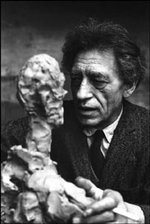Alberto Giacometti
|
|
Alberto Giacometti (October 10, 1901 – January 11, 1966) was a surrealist sculptor and painter. Giacometti was talented in four mediums — sculpture, painting, drawing and printmaking.
| Contents |
Biography and art
Alberto Giacometti was born in Borgonovo in Val Bregaglia, Switzerland near the Italian border. His father was a painter who encouraged his son's interest in sculpture.
After finishing high school, he moved to Geneva to attend the School of Fine Arts. In 1922 he moved to Paris to study at the Académie de la Grande Chaumière in Montparnasse under Auguste Rodin's associate, the sculptor Antoine Bourdelle. It was there that Giacometti experimented with the cubist method. Drawn more to the surrealist movement, after his brother, Diego Giacometti, joined him as his assistant by 1927 Alberto displayed his first surrealist sculptures at Salon des Tuileries. Before long, he was regarded as one of the leading surrealist sculptors of the day.
Living in the creative community of Montparnasse, he associated with artists Joan Miró, Max Ernst and Pablo Picasso, plus writers Samuel Beckett, Jean-Paul Sartre, Paul Eluard and André Breton, and wrote and drew for Breton's magazine Le Surréalisme au Service de la Révolution.
From 1935 to 1940 Giacometti concentrated his sculpting on the human head, focusing on the model's gaze, followed by a unique artistic phase in which his statues became stretched out — their limbs elongated.
During World War II, he lived in the safety of Geneva where he met Annette Arm. In 1946 he and Arm returned to Paris where in 1949 they married. Giacometti's most productive period followed the marriage. His wife provided him with the opportunity to constantly to be in touch with another human body, particularly a feminine one. Models who had posed for him found it a difficult job, but Arm patiently sat for him for hours until he achieved what he wanted.
He soon had an exhibition of his works at the Gallery Maeght in Paris and at the Pierre Matisse Gallery in New York City for which his friend, Jean-Paul Sartre, wrote the catalogue's preface.
By the early 1950s, the use of bronze had become affordable (metals were in short supply during World War II) and Giacometti began to cast his works in bronze.
Obsessed with creating his sculptures exactly as he envisioned through his unique view of reality, to his own consternation and because of his drive for perfection, he carved them very small — many no larger than a pack of cigarettes and almost as thin as nails. A friend of his once said that if Giacometti decided to carve you, he would make your head look like the blade of a knife. However, after his marriage, he was able to make tiny sculptures larger. But the larger that they grew, the thinner they became. Giacometti said that was the way he wanted to represent the sensation he felt when he looked at a naked woman.
GiacomettiRued'Alesia.jpg
Commissioned to design a medallion depicting Henri Matisse in 1954, he created numerous masterful drawings of the great painter in the last months of Matisse's life.
1956 saw a further development in his work when he began to produce paintings of recognizable likenesses.
In 1962, he was awarded the grand prize for sculpture at the Venice Biennale, and the award brought with it worldwide celebrity. Even when he had achieved popularity and his works were in demand, he still reworked models, often destroying them or setting them aside to be returned to years later.
The prints produced by Giacometti are often overlooked but the catalogue raisonné Giacometti - The Complete Graphics and 15 Drawings by Herbert Lust (Tudor 1970) comments on their impact and gives details of the number of copies of each print. Some of his most important images were in editions of only 30 and many were described as rare in 1970.
In his later years, Giacometti creations displayed at a number of large exhibitions throughout Europe. Riding a wave of international popularity, in 1965, despite being in poor health, he traveled to the United States for an exhibition of his works at the New York Museum of Modern Art.
As his last work he prepared the text for the book Paris sans fin, a sequence of 150 lithographs containing memories of all the places where he had lived.
Alberto Giacometti died in 1966 of heart disease and chronic bronchitis at the Kantonsspital in Chur, Switzerland. His body was returned to his birthplace in Borgonovo, where he was interred close to his parents.
Legacy
Before 2005, a sculpture by Giacometi sold for as much as $14 million.
Selected works
Sculptures
- Spoon Woman - (1926)
- Gazing Head - (1928)
- Caress (Despite Hands) - (1932)
- Woman with Her Throat Cut - (1932)
- The Palace at 4 A.M. - (1932)
- Nose - (1947)
- Man Walking - (1947)
- The Chariot - (1950)
- Le Chien - (1951)
- Grande femme IV - (1960)
- Tall Figure II and Tall Figure III - (1960)
Paintings and drawings
- Self-Portrait - (1921)
- The Couple - (1926)
- The Artist's Mother - (1937)
- Apple on the Sideboard - (1937)
- Stehende Figur - (1947)
- The Street - (1952)
- Landscape at Stampa - (1952)
- Diego in a Plaid Shirt - (1954)
- Rue D'alesia - (1954)
- Annette in the Studio - (1954)
External link
- The Museum of Modern Art 2001-2002 Giacometti exhibition. (http://www.moma.org/exhibitions/2001/giacometti/start/goflash.html) (Requires Flash.)de:Alberto Giacometti
es:Alberto Giacometti fr:Alberto Giacometti it:Alberto Giacometti he:אלברטו ג'קומטי ro:Alberto Giacometti


